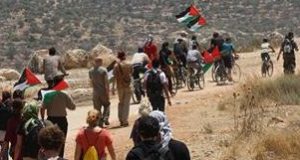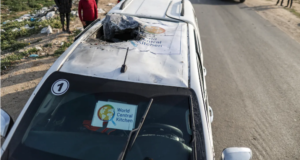By Fred Schlomka
As the eyes of the world are on the Liberty Ships approaching Gaza, a massive segregated road project in the Greater Jerusalem area is quietly approaching completion. Israel is about to unveil the realization of former Prime Minister Ariel Sharon’s dream of Palestinian ‘transportational contiguity’, in lieu of contiguous territory. Route 1, currently shared with Palestinians, connects Jerusalem to the eastern settlement of Ma’ale Adumim (pop. 35,000). This four-lane highway leads to the Dead Sea and also whisks settlers to Jerusalem in twenty minutes through the ‘E1’ development area. Since Sharon’s ultimate goal was to remove Palestinian traffic from settler roads, he came up with the ingenious plan to build a separate road network for exclusive Palestinian use, with no connection to the settler roads, only bridges and underpasses.
The crown jewel of this Orwellian nightmare, renamed the ‘Fabric of Life Roads’, is currently being readied for use and will complete the territorial separation between the north and south West Bank. Several new steep and narrow roads snake through the hills south of E1 from the Palestinian enclaves of Azariya (Bethany), Adu Dis and adjacent villages. They all merge into a single two-lane road that dips under Route 1, curving around the northeast edge of Jerusalem. The road will soon be extended to enter Ramallah, completing the entire segregated road network through the E1 area.
All Palestinian traffic from the southern West Bank will be forced to use these roads when traveling to the northern West Bank. This will be accomplished through the simple maneuver of physically blocking access to Route 1 from Azariya, which currently funnels all northbound Palestinian traffic. Palestinians will wake up one morning and find that a short fifteen-minute trip from Azariya to Ramallah has turned into a lengthy trek of 1-2 hours. The trip from Bethlehem to Ramallah could take 3-4 hours depending on the backup at the Container Checkpoint and traffic density. Tourists or Israelis can travel from Bethlehem to the Ramallah checkpoint at Kalandia in about twenty minutes through Jerusalem in good traffic.
Other segregated road sections have already opened to the south and west of Ramallah from villages ‘caught’ on the west side of Israel’s ‘Separation Barrier’. The Bir Naballah area is now cut off from Jerusalem forcing residents to drive out of the enclave to the north through a sealed road under Route 45, leading to Ramallah. Route 443, going north from Jerusalem to Modi’in has left numerous Palestinian villages cut off to the West. Another network of segregated roads is now connecting these villages to Ramallah though Route 443 underpasses. South of Jerusalem a similar road network is also underway in order to clear Route 60 of Palestinian traffic and allow the settlers of the Gush Etzion block exclusive use of the road. North of Jerusalem Route 60 is the main road leading to the settlements of Ofra, Shilo and beyond. This may well be the next target of Israel’s drive to remove Palestinians from settler highways.
Further north there is a four-lane highway, Route 5, stretching from Tel Aviv to the Central West Bank settlement of Ariel (pop. 25,000) allowing settlers to travel to Tel Aviv in twenty minutes. Construction recently began on the next phase of Route 5, going east past Ariel to Route 60, eventually reaching Route 90 in the Jordan Valley. The completion of Route 5 will permanently divide the northern West Bank with an Israeli controlled strip, and enable settlers in the central Jordan Valley to reach Tel Aviv in forty-five minutes, a trip that now takes more than two hours.
Thus there will be two populations, Israeli and Palestinian, using the same space simultaneously and separately. They will pass each other like subway trains, each on their own track, on a different elevation, never to meet. The ephemeral presence of 2.5 million Palestinians will eventually have no impact on the ethos of half a million Jewish settlers. The goal will have been reached, an Arab-free environment.
The simultaneous consolidation of the settler and Palestinian road networks will be completed within the next few years. However the Greater Jerusalem system is now in place and could become operational within months. This two-layered state, Israel/Palestine is like a Rubik’s Cube with no solution. No matter which way you twist it there can be no rational outcome.
The political ramifications of this are profound. The heartland of Palestine, East Jerusalem, will be forever gone as the capital of a future Palestinian state, settled by over two hundred thousands Israelis and growing by over 5% per year. The Palestinian neighborhoods remaining in East Jerusalem, bisected by 8-meter high walls and creeping settlements, have already lost their community soul. Without a vibrant Palestinian East Jerusalem, territorial integrity between the north and south West Bank, and a reversal of Israel’s ongoing land grab, there cannot be a viable Palestinian state.
Fred Schlomka (fred@schlomka.com) is the Director of www.ToursInEnglish.com and travels the roads of the West Bank daily.
 International Solidarity Movement Nonviolence. Justice. Freedom.
International Solidarity Movement Nonviolence. Justice. Freedom.



